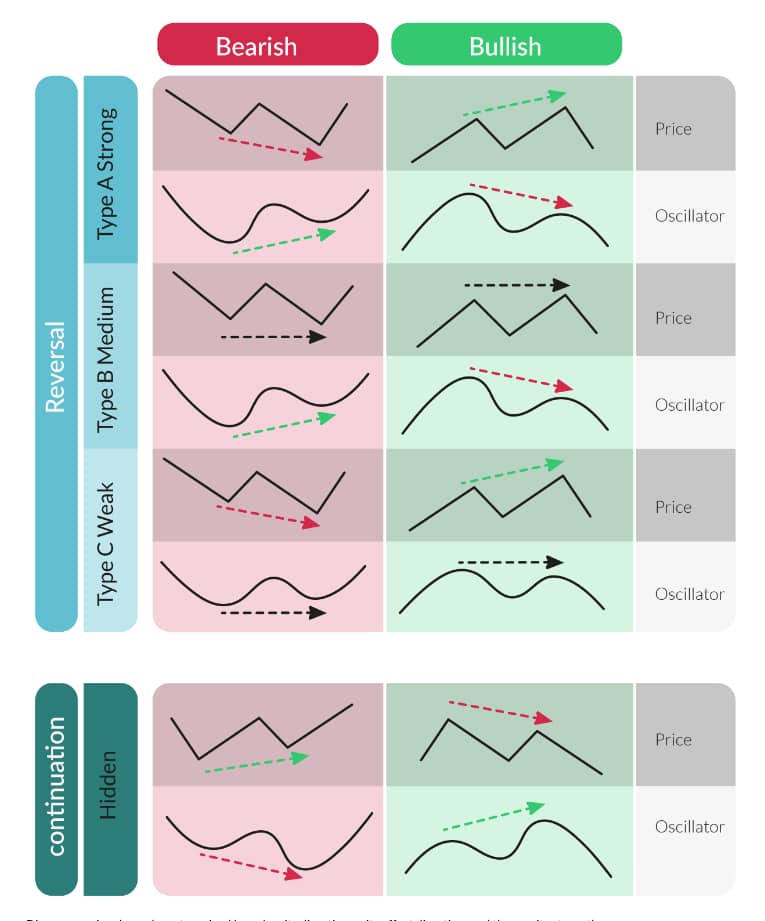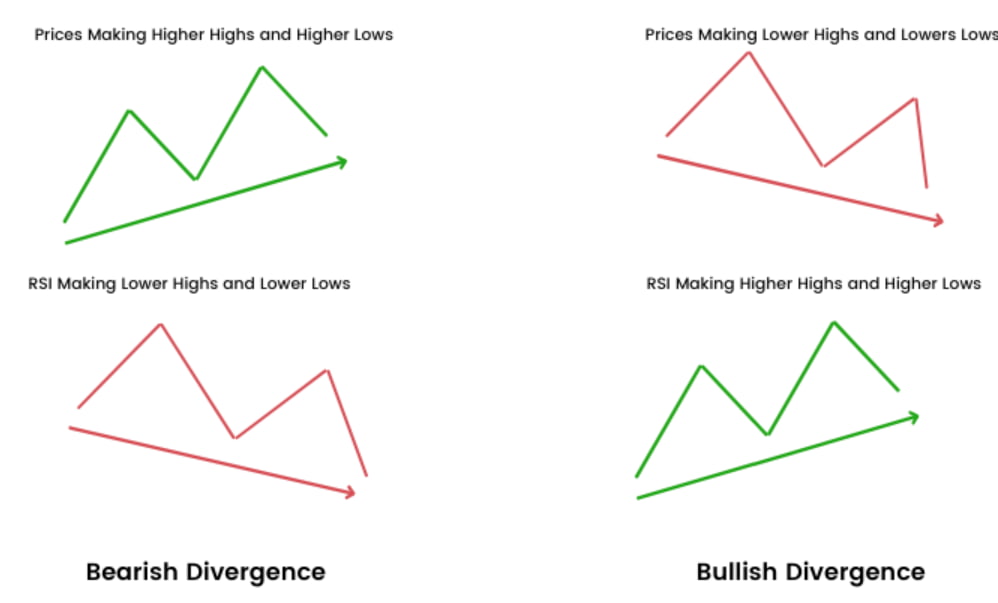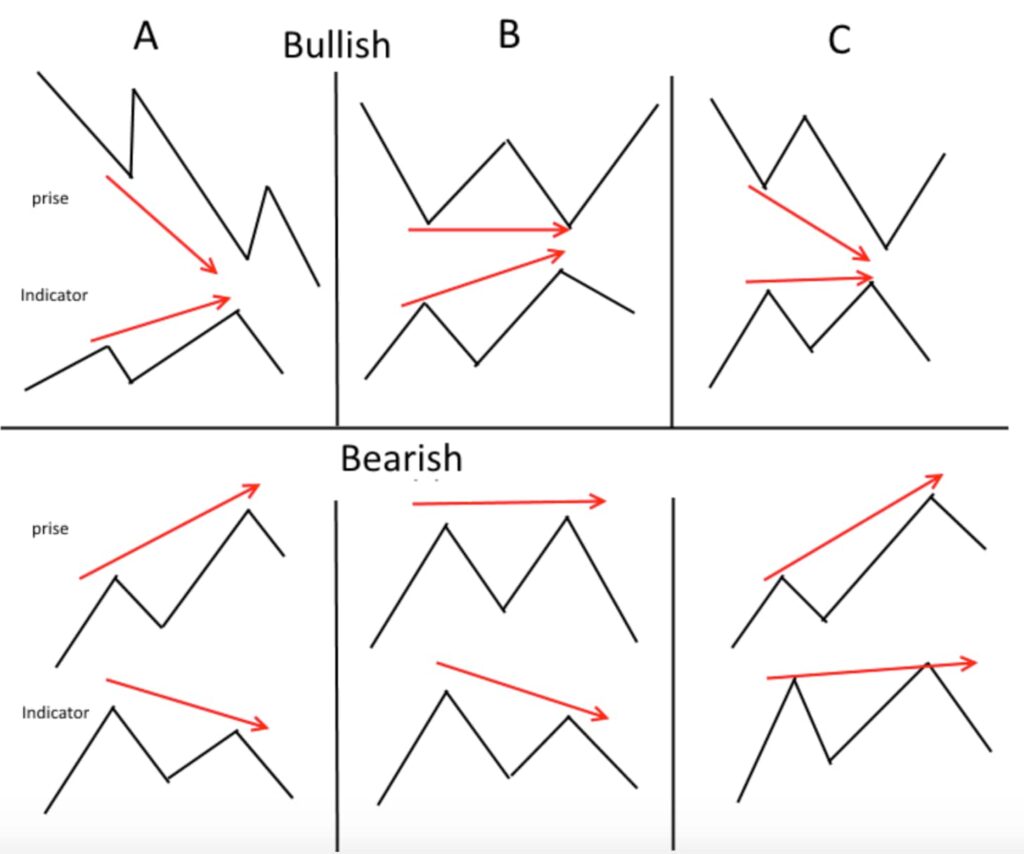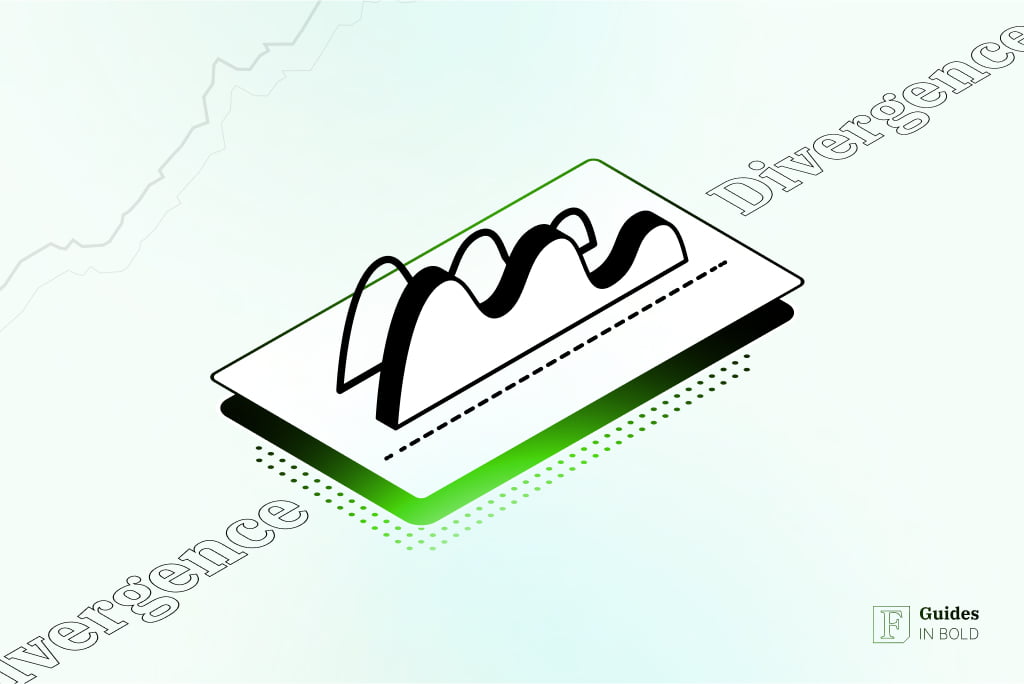The following guide will examine divergence, what it is and what it indicates, how to use this strategy in trading, as well as the pros and cons of using this technical analysis method.
Best Crypto Exchange for Intermediate Traders and Investors
-
Invest in cryptocurrencies and 3,000+ other assets including stocks and precious metals.
-
0% commission on stocks - buy in bulk or just a fraction from as little as $10. Other fees apply. For more information, visit etoro.com/trading/fees.
-
Copy top-performing traders in real time, automatically.
-
eToro USA is registered with FINRA for securities trading.
What is divergence in trading?
Divergences that indicate a reverse can be either negative or positive. A negative divergence occurs when an asset’s price is in an uptrend while the indicator moves lower or shows bearish signals. Conversely, positive divergence happens when the price is in a downtrend, but the indicator is moving higher or showing bullish signs.
Beginner’s corner:
- What is Investing? Putting Money to Work
- 17 Common Investing Mistakes to Avoid
- 15 Top-Rated Investment Books of All Time
- How to Buy Stocks? Complete Beginner’s Guide
- 10 Best Stock Trading Books for Beginners
- 15 Highest-Rated Crypto Books for Beginners
- 6 Basic Rules of Investing
- Dividend Investing for Beginners
- Top 6 Real Estate Investing Books for Beginners
- 5 Passive Income Investment Ideas
Price momentum explained
The length of price swings measures price momentum. Strong momentum is represented by a steep slope and an extended price swing, whereas weak momentum is characterized by a shallow slope and short price swing.
Longer upward swings indicate that momentum is rising, while shorter upswings signal weakening momentum and trend strength. Finally, equal-length upswings demonstrate the momentum has remained unchanged.
Momentum indicators are typically used to smooth out choppy price action and provide a clearer picture of price swings. Specifically, this allows traders to compare the indicator swings to price swings rather than only having to compare price movements.
Divergence can have significant implications for trade management. The amount of divergence is relative, so several patterns can develop in the relationship between the price and an indicator.
While divergence does indicate something is changing, it does not always mean the trend will reverse. Instead, it signals the trader should evaluate their strategy options: holding, selling a covered call (selling a call option while also owning the underlying asset), tightening the stop, or selling.
Remember, to be consistently profitable is to pick the right strategy for what the price is doing, not what you think the price will do.
Best Crypto Exchange for Intermediate Traders and Investors
-
Invest in cryptocurrencies and 3,000+ other assets including stocks and precious metals.
-
0% commission on stocks - buy in bulk or just a fraction from as little as $10. Other fees apply. For more information, visit etoro.com/trading/fees.
-
Copy top-performing traders in real time, automatically.
-
eToro USA is registered with FINRA for securities trading.
Types of momentum indicators
The way to a successful trade lies in the ability to implement the correct strategy for price action. Common types of momentum indicators for measuring price movements include:
- Relative strength index (RSI);
- Stochastic oscillator;
- Moving average convergence divergence (MACD);
- Rate of Change (ROC).
Types of divergence trading
There are two types of divergence, regular and hidden, which can each be either bullish or bearish. While regular divergence can signal potential trend reversals, hidden divergence points to a continuation of the trend (the price continues to move in its current direction).
In short, regular divergence exhibits momentum leaving the trend, which could be an early sign of a reversal. Hidden divergence, on the other hand, depicts momentum coming into the current trend, making a continuation more likely.

Regular divergence trading: Trend reversal signal
Divergence can be either positive or negative. Positive divergence happens when the price of a security makes a new low while the plotted indicator starts to climb. As a result, traders may conclude that the price is losing its downward momentum, and a trend reversal may soon be approaching.
On the other hand, a negative divergence is when the price makes a new high, but the indicator makes a lower high, warning of a weakening price trend. The investors can then determine whether to sell the position or set a stop loss in case the price starts to fall.

Traders use divergence to assess the underlying momentum in a security’s price and the likelihood of a price reversal. Understanding divergence can lead to lucrative trades since it helps traders identify and respond to changes in price action.
Example of divergence
The stock depicted in the chart below is experiencing a prolonged downtrend. Having plotted an RSI indicator on the price chart, we can observe that the RSI is climbing while the price continues to drop.

This type of positive divergence can be an early sign that the underlying security price may be reversing. If the security’s price jumps above the downward trendline, this will complete the confirmation, suggesting we take a long position.
Classes of regular divergences
Both bullish and bearish divergences can be classified into three subcategories according to their strength levels:
- Class A divergences: The strongest divergences. Class A divergences indicate the best trading opportunities;
- Class B divergences: Exhibiting less strength than Class A divergences. Class B divergences depict choppy market action and should typically not be followed;
- Class C divergences: The weakest divergences. Class C divergences also depict choppy market action and should typically not be followed.
Class A bearish divergences occur when prices climb to a new high, but the oscillator can only invoke a lower high than displayed in a previous rally. They usually signal a sharp and powerful reversal toward a downtrend.
Conversely, class A bullish divergences happen when prices plummet to a new low as the oscillator reaches a higher bottom than during its previous decline. They are considered reliable signals of an approaching strong rally (short-term sharp upward price move).
Class B bearish divergences occur when prices make a double top (a bearish technical reversal pattern that forms after a security reaches a high price two consecutive times with a subtle decline between the two), with the indicator tracing a lower second top. In contrast, class B bullish divergences are demonstrated by prices tracing a double bottom pattern, with the indicator outlining a higher second bottom.
Class C bearish divergences occur when prices rise to a new high, but an oscillator stops at the same level it reached during the previous rally. Conversely, class C bullish divergences happen when prices fall to a new low while the oscillator traces a double bottom. Class C divergences are most indicative of market stagnation, i.e., neither bullish nor bearish trends are becoming stronger or weaker.

Hidden divergence trading: Trend continuation signal
Hidden divergence is a continuation indicator, suggesting a possible market entry point in the direction of the trend to profit from its continuation.
A hidden bullish divergence happens when the price makes a higher low, but the indicator shows a lower low. It tells us that the oscillator is recharging to go back up again, i.e., an upward trend continues.
A hidden bearish divergence happens when the price makes a lower high, but the oscillator is making a higher high. It tells us that the oscillator is creating space to go back down again, i.e., a downward trend continues.
Divergence vs. confirmation
While divergence happens when the price and indicator provide conflicting signals, confirmation occurs when the price and indicator(s) send the same signals.
Firstly, as technical indicators are not perfect predictors of future price movements, confirmation is crucial for validating the credibility of trading decisions. Secondly, it is used to establish whether the price movement will continue.
Convergence vs divergence
Divergence typically means two indicators are moving apart, while convergence shows how they move together. Thus, convergence is the opposite of divergence. It describes the phenomenon of the price of a futures contract moving toward the spot or cash price of the underlying asset over time. In short, convergence is a way to describe the price action of a futures contract.
Convergence occurs because the market won’t allow something to trade for two prices simultaneously. If, however, there are significant differences between the price of the futures contract and the underlying security, a risk-free arbitrage opportunity will present itself. Yet, risk-free arbitrage opportunities rarely exist because the futures contract price converges toward the cash price as the delivery date approaches.
Ultimately, technical traders pay more attention to divergence than convergence because convergence is assumed to occur in a normal market.

Pros and cons of divergence trading
Price momentum refers to the direction and speed of price changes. Trading divergence is a valuable strategy for gaining insight into price momentum. Though divergence indicates that something is changing, it does not necessarily mean that a reversal is approaching. Now, let’s look at this method’s main advantages and disadvantages.

Pros
- Trading divergence works with various indicators;
- Divergence can assist in spotting trend reversals;
- Divergence helps to detect potential entry and exit points;
- Useful as a stand-alone strategy or in conjunction with other technical tools.

Cons
- Can give out false signals, i.e., point to reversals that never happen;
- Divergence is not present for all price reversals;
- It cannot be relied on exclusively to predict reversals, as it doesn’t provide timely trade signals;
- Divergence can last a long time before a price reversal occurs.
In conclusion
To summarize, divergence alerts traders of weakening price trends, helping them assess the likelihood of the price changing direction to find better and more reliable trade entries. As well as reversals, divergences can also indicate the continuation of a trend.
However, as is true with all forms of technical analysis, investors should use a combination of indicators and analysis methods to confirm their trading decisions before acting on divergence alone.
Disclaimer: The content on this site should not be considered investment advice. Investing is speculative. When investing, your capital is at risk.
FAQs about divergence trading
What is divergence?
Divergence is a strategy used in technical analysis that occurs when the asset price moves away from a technical indicator. Divergence signals that the current price trend is weakening and that a reversal may ensue. A negative divergence occurs when an asset’s price is in an uptrend while the indicator is moving lower. Conversely, positive divergence happens when the price is in a downtrend, but the oscillator is moving higher.
How do regular and hidden divergences differ?
Regular and hidden divergences can each be either bullish or bearish. However, while regular divergence can signal potential trend reversals, hidden divergence points to a continuing trend.
What other tools can traders use with divergence?
Trendlines, as well as support and resistance levels, should be used in tandem with divergence to guide you in making the most profitable trading decisions.
Why do traders use divergence?
It helps them recognize and react appropriately to a shift in price action. Divergence tells the traders something is changing, suggesting a possible redirection in strategy, such as tightening the stop-loss or taking a profit.
How can I tell divergence exists on a chart?
For divergence to exist, the price must have either formed one of the following: higher high than the previous high; lower low than the previous low; Double Top; Double Bottom.
How to confirm divergence?
To confirm divergence effectively, connect the highs or lows on the price chart and on the indicator, ensuring they align. True divergence is indicated when these lines have opposite slopes. Note that divergence signals are stronger in longer time frames and can be less reliable in shorter ones. If the price has already shown a significant move after divergence is spotted, the signal may no longer be valid. To increase reliability, use additional indicators for confirmation and be mindful that divergence strategies work best in trending markets, not in range-bound conditions.
What technical indicators work best with divergence?
Most of the technical indicators used to follow divergence are momentum oscillators. The three most popular indicators for trading divergence are RSI, MACD, and the stochastic oscillator.
What are the limitations of divergence?
As divergence is not present for all price reversals and can occur over extended periods, it is not recommended that it be relied on as a standalone indicator. Instead, it is vital to complement divergence with other technical analysis methods to confirm trading signals.
What is divergence trading in the financial markets?
Divergence trading refers to a strategy used by traders where they identify differences between the movement of an asset’s price and a specific indicator or another asset. When these two elements don’t move in tandem, it suggests a potential reversal or change in the market trend.
How is divergence in the stock market interpreted by traders?
Divergence in the stock market is often seen as an indication that a stock’s current trend may be weakening or about to reverse. When an indicator (like the MACD or RSI) and a stock’s price move in opposite directions, it suggests that the ongoing momentum might be losing strength, and a potential trend change could be on the horizon.
What's an example of divergence in trading?
A typical divergence example would be when a stock’s price reaches a new high, but the RSI, an oscillating indicator, fails to achieve a new high and instead moves lower. This indicates that while the price is increasing, the momentum behind it might be slowing down, suggesting a potential upcoming price reversal.
What's the difference between divergence vs convergence?
Divergence and convergence in trading are concepts related to the relationship between a financial asset’s price and a technical indicator. Divergence occurs when the price and indicator move in opposite directions, indicating a potential trend reversal. Convergence, on the other hand, happens when the price and indicator move in the same direction, confirming the current trend’s strength.
Best Crypto Exchange for Intermediate Traders and Investors
-
Invest in cryptocurrencies and 3,000+ other assets including stocks and precious metals.
-
0% commission on stocks - buy in bulk or just a fraction from as little as $10. Other fees apply. For more information, visit etoro.com/trading/fees.
-
Copy top-performing traders in real time, automatically.
-
eToro USA is registered with FINRA for securities trading.





